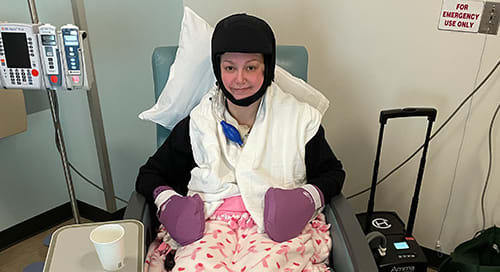Head and Neck Cancer Care
When you’re a patient at Providence, we don’t just treat your head and neck cancer – we treat you. We use the most advanced treatments to create a highly personalized care plan. We also support you and your loved ones with a full range of services throughout your entire cancer journey. The result is effective, whole-person care for your body, mind and spirit.
Why Choose Us for Head and Neck Cancer Care?
At Providence, we see the life in you. Together, let’s finish cancer – so you don’t have to miss any of life’s special moments.
About Head and Neck Cancer
Head and neck cancers are cancers that form in the larynx, throat, salivary glands, sinuses or mouth. They are often caused by exposure to toxins like alcohol or tobacco, including chewing tobacco. The expert oncology teams at Providence use the most effective therapies to treat patients with every type of head and neck cancer and its related conditions, including:
- Salivary gland cancer
- Laryngeal cancer
- Nasal cancer
- Nasopharyngeal cancer
- Oropharyngeal cancer
- Oral cancer
Testing and Diagnostics

Diagnostic tools help our cancer clinicians determine which therapies will work best for each patient, based on many factors like cancer type and the genetic or molecular profile of the tumor. Your doctors will use multiple advanced diagnostic and prognostic tools to help design your individualized treatment plan. Depending on your case, this may include:
- NavDX monitoring during and after treatment Note: This advanced therapy is not available at all Providence locations.
Personalized Treatment for Head and Neck Cancer
We take a team approach to your head and neck cancer treatment because we know this offers the best success in controlling and curing cancer. Your multidisciplinary cancer care team will work with you to design an individualized cancer care plan, from diagnosis to post-treatment support. We offer many different therapies across our Providence locations. Depending on your condition, your personal care plan may include one or more of the following:
Systemic therapies travel through the bloodstream and affect cells in other body parts. They are used for patients whose cancer has spread to other areas of the body or if there’s a high risk of spread. Sophisticated genetic analysis allows us to target therapies to specific DNA mutations that cause cancer cells to develop and grow. Systemic therapies include:
Chemoradiotherapy combines the use of chemotherapy and radiation at the same time. When given together, the two treatments are more effective than when given in sequence. This approach is often used when a cancer is advanced but has not spread to distant parts of the body and therefore may respond to more intense therapy.
Chemotherapy is the systemic use of cytotoxic chemicals to kill cancer cells. Today there are many medications (e.g., biological medications, immune treatments, targeted therapies) that do not fit the classic definition of chemotherapy yet are often included in this category.
Clinical trials represent research protocols that include the use of new drugs or drug combinations in a specific clinical situation.
Immunotherapy uses drugs to allow the body’s own immune system to more effectively find and destroy cancer cells.
Targeted therapies (oral and intravenous (IV) biologics) represent a group of drugs and biologic compounds that attack a specific mutation or antibody expressed by a specific cancer. The advantage of these drugs is that they concentrate on the cancer cell, sparing normal cells from most side effects.
Surgical therapies involve an operation or procedure to remove cancer from the body. Surgery may be the main treatment for some invasive cancers, but it’s only one part of the entire treatment plan. Surgical therapies include:
Auriculectomy is surgical removal of part of the ear.
Composite resection of mandible is surgical removal of a section of the mouth, tongue and lower jaw.
Endoscopic medial maxillectomy is a surgery to treat cancer and other conditions of the sinuses.
Excision of skin cancer is the removal of growths such as cysts, moles and skin cancers.
Excision of submandibular gland is surgical removal of one or both salivary glands under the jaw.
Free tissue transfer is surgery to transfer tissue from "flaps" in the arm, leg or shoulder. The transferred tissue could be skin, fat, muscle, nerves or bone.
Glossectomy is a surgical procedure to remove part or all of the tongue.
Laryngectomy is surgical removal of some or all of the voice box (larynx).
Local rotation flap is surgery to help reconstruct a part of the body that has been removed during cancer treatment.
Mandibulectomy is surgical removal of part of the lower jaw. Bone from another part of the body may be used to reconstruct the jaw.
Marginal resection of mandible is surgical removal of cancerous growths in the floor of the mouth that have spread to the bone.
Maxillectomy (partial/total) is surgical removal of part of the upper jaw.
Modified radical neck dissection lymphadenectomy is surgical removal of lymph nodes between the jaw and collarbone.
Orbital exenteration is surgical removal of an eye and other structures and tissues in the orbital area.
Parotidectomy is surgical removal of all or part of the parotid gland, a type of salivary gland.
Pedicled myocutaneous flap is a reconstructive surgery in which tissue, muscle and connective tissue called fascia are moved from one area of the body to reconstruct another area.
Pharyngectomy is surgical removal of all or part of the esophagus. It is used to treat throat cancer.
Rhinectomy is surgical removal of some or all of the nose in order to remove a tumor.
Selective neck dissection lymphadenectomy is surgical removal of some lymph nodes in the neck. It can help detect or prevent the spread of cancer cells.
Transoral laser resection of oropharyngeal/hypopharyngeal/laryngeal tumor is surgical removal of tumors in the throat, including the voice box (larynx).
Transoral robotic surgery is a procedure to remove cancerous growths on the soft palate, the back of the tongue, the tonsils and other tissues at the back of the mouth.
Radiation therapy uses high-energy radiation from a source like X-rays or photons to kill cancer cells or shrink tumors. It may be part of a treatment plan that also includes systemic therapies and/or surgery. Radiation is sometimes used to help ease a patient’s pain or discomfort. Radiation therapies include:
Intensity-modulated radiation therapy (IMRT) and volumetric-modulated arc therapy (VMAT) are advanced types of radiation therapies. IMRT uses advanced technology to manipulate the radiation beams to conform to the shape of a tumor. VMAT is a subtype of IMRT in which the machine actively delivers radiation beams while moving in an arc around the patient.
This method of radiation delivery offers next-generation capabilities. The arc-based therapy provided via VMAT delivers high doses of radiation to more focused areas, reducing side effects and the overall treatment time for the patient. This treatment is particularly effective at treating several types of cancer while at the same time reducing toxicity and harm to vital organs.
This procedure is one of several new ways to deliver radiation therapy. It requires a sophisticated facility and equipment, along with highly specialized physicians. It is available at some Providence locations.
Stereotactic radiation (SABR/SBRT) is a group of treatments that includes stereotactic body radiation therapy (SBRT) and stereotactic ablative radiation (SABR) – both of which are adaptations of stereotactic radiosurgery (SRS) – for the treatment of targets in the body, but outside the brain. Similar to SRS, these techniques deliver very high doses of radiation using sophisticated motion management and patient immobilization techniques.
The number of radiation treatments is minimal and may range from one to five treatments delivered over one to two weeks.
This procedure is one of several new ways to deliver radiation therapy. It requires a sophisticated facility and equipment, along with highly specialized physicians. It is available at some Providence locations.
Surface-guided radiation therapy (SGRT/SIGRT) is an approach to radiation targeting that offers real-time beam guidance from face and body surface-recognition systems.
This treatment is particularly effective at treating several types of cancer while at the same time reducing toxicity and harm to vital organs, thus minimizing side effects.
This advanced procedure requires a sophisticated facility and equipment, along with highly specialized physicians. It is available at some Providence locations.
Three-dimensional conformal radiation therapy (3DCRT) is a radiation planning and treatment technique in which three-dimensional (3D) imaging enables improved targeting for radiation treatment. 3D planning with CT imaging makes radiation treatment much more conformal, or tailored to the target.
Find Head and Neck Cancer Care Close to You
Accreditations
We are proud to see our dedication to our cancer patients recognized by some of the most well-respected programs and institutions in the United States. Several of our Providence locations have achieved the following accreditations:
- Accountable Care Organizations (ACO) Accreditation – National Committee for Quality Assurance (NCQA)
- American College of Radiology (ACR) Accreditation
- Accreditation Program for Excellence (APEx) – American Society of Radiation Oncology (ASTRO)
- Commission on Cancer (CoC) Accreditation – American College of Surgeons (ACS)
- Integrated Network Cancer Program (INCP) – American College of Surgeons (ACS)
- Quality Oncology Practice Initiative (QOPI) Certification – American Society of Clinical Oncology (ASCO)
Meet the Team
At Providence, you'll have access to a vast network of dedicated and compassionate providers who offer personalized care by focusing on treatment, prevention and health education.

Find Clinical Trials
Are you looking for a clinical trial for yourself or for a patient? We’d love to help you find one!
Find Care
Expert Tips and Advice for Cancer





